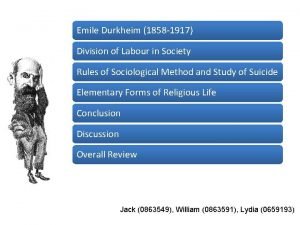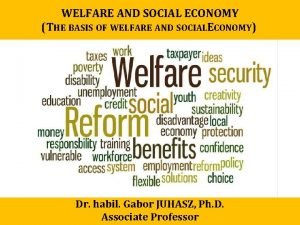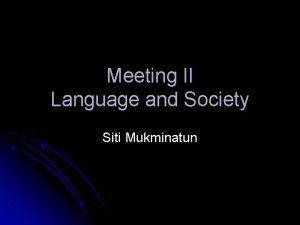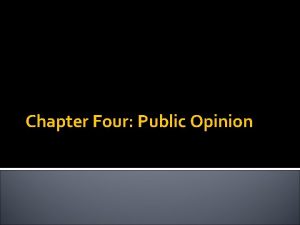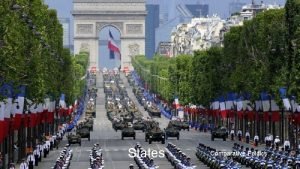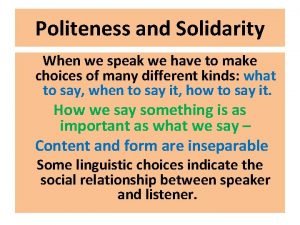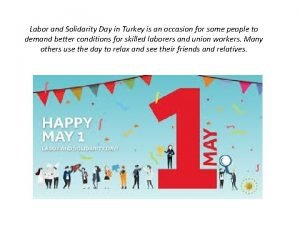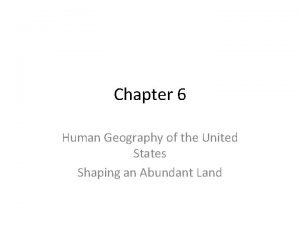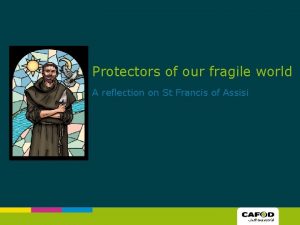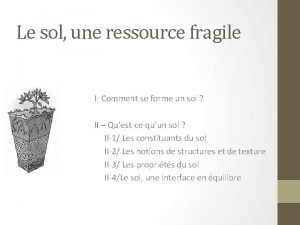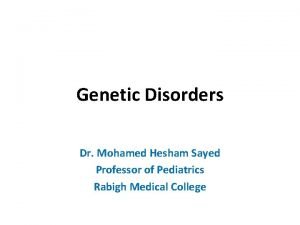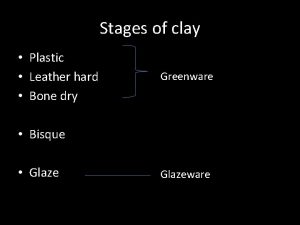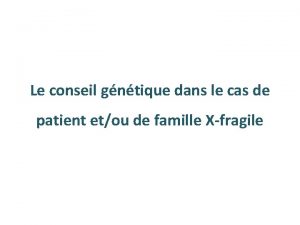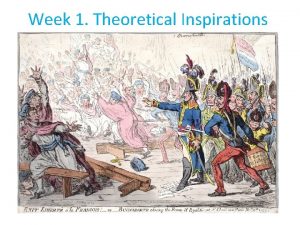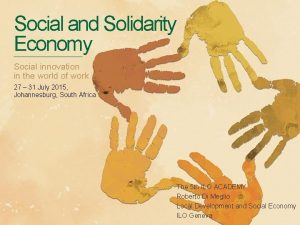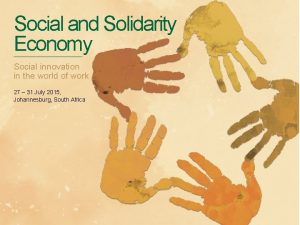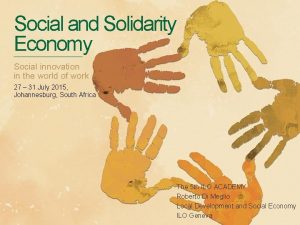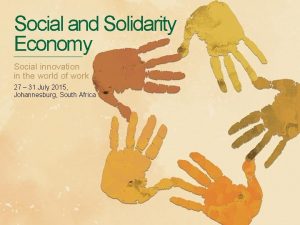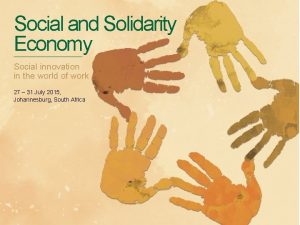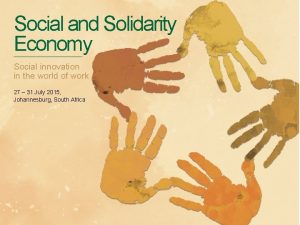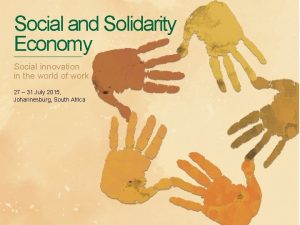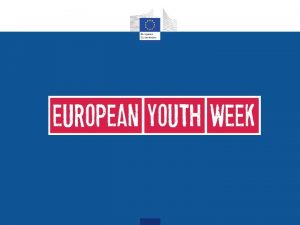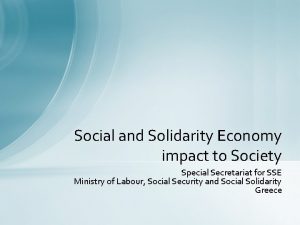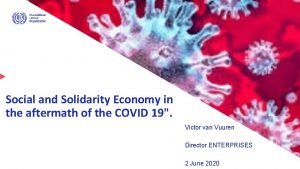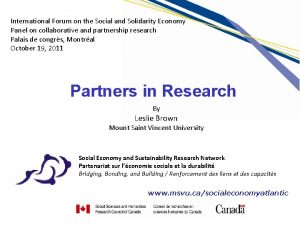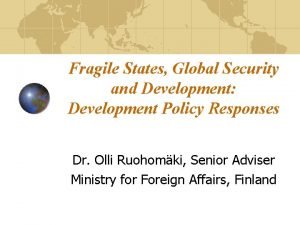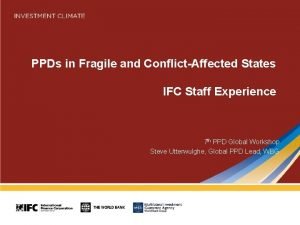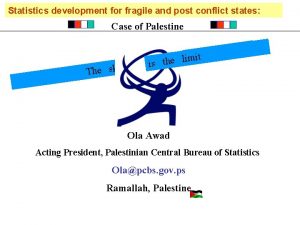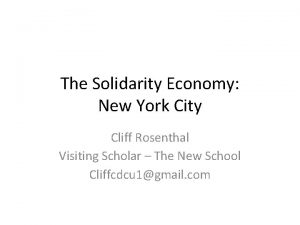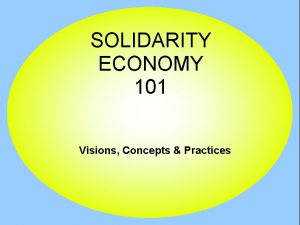The Social and Solidarity Economy in Fragile States


























- Slides: 26

The Social and Solidarity Economy in Fragile States An elective at the 5 th ILO Social and Solidarity Economy Academy Johannesburg, 27 – 31 July 2015

Content 1. 2. 3. 4. Fragile States, fragile situations, fragility The ILO in fragile states The social and solidarity economy in fragile states Debate 2

What are Fragile States? OECD: fragile states are “Those failing to provide basic services to poor people because they are unwilling or unable to do so” DFID: fragile states are: “those where the government cannot or will not deliver core functions to the majority of its people, including the poor. ” World Bank: in fragile states “state policies and institutions are weak, making them vulnerable in their capacity to deliver services to their 3 citizens, to control corruption, or to provide for sufficient voice and accountability. They face risks of conflict and political instability”

Fragile States Index 12 Criteria n n n Demographic Pressures Refugees and IDPs Group Grievance Human Flight Uneven Development Poverty and Economic Decline Legitimacy of the State Public Services Human Rights Security Apparatus Factionalized Elites External Intervention 11 Categories n n n Very sustainable Sustainable Very stable Stable Less stable Warning High warning Very high warning Alert High alert Very high alert

Fragile States Index 2015 5

Why focus on Fragile States? n n n In 2014, 48 countries were classified as fragile states according to a combined list prepared by on As. DB, Af. DB, OECD and World Bank. About 1. 25 b people live in countries affected by fragility, conflict and violence. Fragile States have higher poverty rates, lower growth rates, and weaker human development indicators than other lowincome countries. Fragile States are least likely to achieve the Millennium Development Goals. Fragile States may have a destabilizing effect on neighboring countries as well. Fragile States are also diverse: conflict, post-conflict, chronically violent, rapidly growing, slow-growing, resourcerich, resource-poor, very large and very small. 6

Gender and Fragile States n n Women living in fragile states are even more marginalised and vulnerable to poverty, violence, and lack of rights. Fragile states may turn to gender-discriminatory traditional, religious and customary law because of ineffective state institutions and weaknesses in state-building Young men vulnerable to engaging in an fall out from violence. Gender equality often overlooked in state building in fragile states. The SSE in Fragile States 7

Fragile States or Fragility? A state of fragility can be understood as a period of time during nationhood when sustainable socio-economic development requires greater emphasis on complementary peacebuilding and state building activities such as building inclusive political settlements, security, justice, jobs, good management of resources, and accountable and fair service delivery. (G 7+ definition) 8

Factors of Fragility 9

A fragile situation in Ukraine 10

Fragility or crisis situations? n n n Post-conflict: reconstruction after war and civil strife; capacity and institution building; reintegration of armed forces; Post-disaster: reconstruction after catastrophic events (floods, earth quakes, hurricanes etc. ) Political instability: protests, frequent changes in government, breakdown of delivery systems Causes and effects of conflict, disaster and instability are different, but the response may be similar: jobs, dialogue, protection, rights Conflict and disaster may be mutually reinforcing: ¡ ¡ ¡ Tsunami response in Japan and Indonesia Ebola response in Sierra Leone and Nigeria Earthquake response in Haiti and in Chile 11

Rationale for ILO Intervention n n n n The very origin of the ILO The ILO Constitution: “Whereas lasting peace…” R. 71: From War to Peace: towards a new Recommendation in 2016/17 35 to 50 ILO member States considered fragile; ILO Flagship programme «Jobs for Peace and Resilience» Longstanding experience, proven strategies and tools Large TC portfolio in fragile states: 360 projects in 38 fragile countries Global shift of priorities towards fragile states 12

ILO DC in Fragile States 13

ILO Intervention n ILO has implemented/implements TC projects in all 20 G 7+ countries; around 14% of ILO’s TC portfolio is located in fragile States, and active DWCPs exist in 16 of the 20 G 7+ member States; Four Fragile States (Afghanistan, Haiti, Somalia and Timor Leste) are among the top ten recipients of ILO TC; The principal ILO intervention modalities in fragile States are: ¡ ¡ n Strengthening labour market governance through social dialogue Promoting employment opportunities and social protection for women and men under a coherent and comprehensive policy framework for socioeconomic reintegration and poverty alleviation of households and communities. Addressing young women and men in vulnerable employment conditions to contribute to stabilization and conflict resolution Reintegration of armed forces, including child soldiers; In most cases ILO works in partnership with other UN organizations 14

Lessons learned n n n Relevance: Vulnerable groups such as youth and women receive much needed attention to stabilize post-conflict settings, improve the security of communities and consolidate peace- and state-building activities. However, displaced and disabled people are not sufficiently targeted. Effectiveness: the ILO has a comprehensive range of technical expertise to address both basic needs at local level, as well as enhancing labour market governance at policy level. However, the ILO faces difficulties in responding rapidly to sudden onset emergencies. Efficiency: the ILO frequently collaborates with UNCTs and has jointly implemented projects with 20 UN partner agencies in fragile States. However, further improvement is needed when it comes to interagency coordination. Impact: working with ILO constituents facilitates national ownership, but what is expected from tripartite constituents in fragile countries can exceed their capacities. This call for the development and involvement of local expertise for a sustainable impact. Sustainability: the ILO’s post-conflict interventions fostering, for instance, livelihood resilience and the reintegration of ex-combatants, serve as an entry point to develop coherent and integrated ILO programmes later on. This supports country transition from short-term projects and programming to longer-term policy-making. 15

Partnerships n n n UNDP and ILO spearheaded the UN Policy for Post. Conflict Employment Creation, Income Generation and Reintegration; The ILO is an active member of the Inter-Agency Standing Committee’s (IASC) working groups on disaster preparedness, early recovery and post emergency situations; ILO is a full member of the International Dialogue on Peacebuilding and Statebuilding; ILO is the only UN agency that has signed an Mo. U with the G 7+ (Brussels meeting) Advanced discussion with the Peacebuilding Support Office on a temporary secondment of an ILO expert. 16

ILO – G 7+ Partnership

The SSE and Fragility n n The State does not deliver, alternative delivery channels are needed; Social and solidarity economy organizations facilitate self -help and mutual assistance with the aim of providing essential services that the State no longer provides. Modern cooperatives and other social and solidarity economy organizations emerged in the middle of the 19 th century as a crisis-response mechanism. Even though they provide essential services SSE organizations must strive for economic sustainability. 18

What kind of services? Economic Social Societal Access to water, energy, essential supplies Care for the elderly, children, orphans, sick and injured Defence of interests and rights, gender equality Job creation Social assistance and mutual aid, including food Voice and representation, advocacy Financial Intermediation Protection, including microinsurance Extended social dialogue The SSE in Fragile States 19

Psychological aspects n n n Building trust and confidence Creating hope through joint work and mutual assistance Peacebuilding as a common goal The Kibbutzim in Israel: building a new state through collective action Agricultural cooperatives in Croatia: bringing enemies together through a common goal Community groups in Korea: rebuilding the country after war 20

“Trümmerfrauen” The SSE in Fragile States 21

Reintegration SSE as Recipient Welcome returnees (displaced, soldiers, orphans) SSE as service providers Provide training Provide a home Facilitate access (to land, assets, finance, markets etc. ) Bridge ethnic divide Organize social support, protection and security 22

The SSE and the PSGs 1. 2. 3. 4. 5. Legitimate politics: Foster inclusive political settlements and conflict resolution. Security: Establish and strengthen people’s security. Justice: Address injustices and increase people’s access to justice. Economic Foundations: Generate employment and improve livelihoods. Revenues & Services: Manage revenue and build capacity for accountable and fair service delivery. 1. 2. SSE as instruments to foster inclusivity, understanding and peoples’ participation SSE for mutual assistance and neighbourhood watch 3. SSE as promotors of equality and social justice 4. SSE as creators of jobs and livelihoods 5. SSE as providers of services 23

SSE and gender equality n n SSE can promote women’s inclusion in social dialogue and governance leading to social stability. SSE can provide a better understanding of local gender context through grassroots SSE organisations. SSE can provide services that promote women’s access to the world of work and provide employment for women. SSE can address men’s vulnerabilities and post traumatic backlash after conflict. 24

Prerequisites 30/10/2021 Must be genuine, authentic and owned by their members Must be economically and financially selfreliant Must adapt to the cultural and religious context Must have a strong and respected leadership Must not be seen as a miracle solution 25

Questions for debate 1. 2. 3. 4. Could the SSE have played a role before, during and after the Ebola outbreak? Can the SSE work successfully if based on just a common goal (not necessarily a common bond)? What are the non-financial, non-economic aspects of the SSE in fragile, post-crisis and post-disaster situations? Do we need SSE laws and policies in fragile situations? 26
 Organic solidarity vs mechanical solidarity
Organic solidarity vs mechanical solidarity Welfare economics examples
Welfare economics examples Define social solidarity
Define social solidarity Referential and affective function scales
Referential and affective function scales Athens vs sparta differences
Athens vs sparta differences Public opinion is both an elusive and fragile commodity.
Public opinion is both an elusive and fragile commodity. Fragile comparative and superlative
Fragile comparative and superlative Solidarity and politeness
Solidarity and politeness Labor and solidarity day ne demek
Labor and solidarity day ne demek Activity 1 let's review
Activity 1 let's review Chapter 6 human geography of the united states
Chapter 6 human geography of the united states Agile ceremonies
Agile ceremonies Hypberbole
Hypberbole Couchée avec mes soeurs j'ai la tete rouge reponse
Couchée avec mes soeurs j'ai la tete rouge reponse Agile is fragile
Agile is fragile Our fragile earth reflection
Our fragile earth reflection Our fragile earth reflection
Our fragile earth reflection Sol fragile
Sol fragile Fragile x syndrome baby
Fragile x syndrome baby Klinefelter's syndrome
Klinefelter's syndrome Bone dry clay stage
Bone dry clay stage Macroorchidia
Macroorchidia Fragile x syndrome female
Fragile x syndrome female Mechanical solidarity definition sociology
Mechanical solidarity definition sociology Mechanical solidarity definition sociology
Mechanical solidarity definition sociology Symbolic interactionist perspective
Symbolic interactionist perspective Definiton of justice
Definiton of justice
